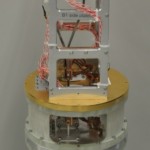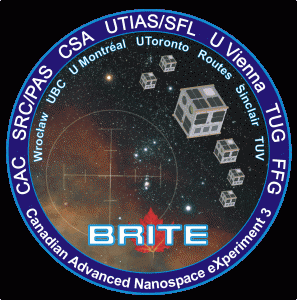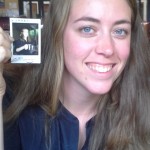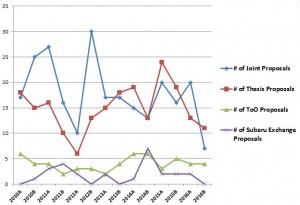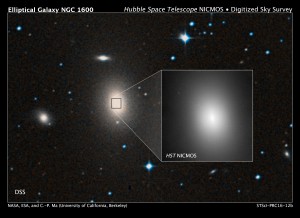From/de Denis Laurin, Senior Program Scientist, Space astronomy, Space Exploration development, CSA,
with contributions from/avec des contributions de Jean Dupuis, Senior mission scientist
(Cassiopeia – Summer/été 2016)
Congratulations to John Hutchings

Figure 1 – Left to right: Sylvain Laporte (CSA President); John Hutchings (NRC); David St-Jacques (CSA astronaut).
In recognition of his exceptional contribution to the Canadian Space Program, Dr. John B. Hutchings was presented with the John H. Chapman Award of Excellence during a ceremony at the 17th Conference on Astronautics of the Canadian Aeronautics and Space Institute (CASI ASTRO 2016) in Ottawa, Ontario.
The Chapman Award is a tribute to the distinguished career and achievements of an extraordinary individual, whose vision and contributions have shaped Canada’s space program.
JAXA Hitomi
Despite the unfortunate premature end of the Hitomi X-ray observatory on March 26, JAXA did collect valuable scientific data (during the commissioning phase). A report published on the JAXA website describes the event (Hitomi report). The science team is analysing the available data (mainly SXS instrument) and significant science results will soon be published. Furthermore, the Canadian contribution of the laser metrology system (CAMS) built by Neptec demonstrated excellent performance.
ISRO ASTROSAT
Contributed by Jean Dupuis, Senior Mission Scientist, CSA

Figure 2 – UVIT FUV image of the central region (~3 arcmin) of the globular cluster NGC 1851 (FUV CaF2 filter, exposure time of 10 minutes, provided by John Hutchings, NRC-Herzberg)
The first call for proposals for the ASTROSAT Canadian open time (5%) has been issued with a deadline of July 29th (see recent e-mail by John Hutchings to CASCA mailing list). Support to Canadian proposers is to be provided by Joe Postma of the University of Calgary (jpostma@ucalgary.ca). UVIT is reportedly performing well and commissioning activities are mostly completed and the observatory has initiated its science programme. The Figure below shows one such science verification image obtained with UVIT’s Far-UV channel of the globular cluster NGC 1851. This work is done in collaboration with the UVIT team at the Indian Institute of Astrophysics (IIA).
CSA MOST Archive
Described in more detail in the spring issue of e-Cass, the MOST mission data archive is essentially completed, thanks to the effort of Dr Vinothini Sangaralingam, Visiting Fellow (CSA / NSERC) in close collaboration with CADC (David Bohlender, for implementation and maintenance) and MOST science team members. For further information on the MOST mission and data availability, please contact the MOST Mission Scientist, Jaymie Matthews: matthews@astro.ubc.ca.
CSA JWST Science Support
Contributed by Jean Dupuis, Senior Mission Scientist, CSA
CSA is working on a plan to provide science support for data analysis during the JWST mission where 5% of the open observation time will be available to Canadian astronomers. We encourage the community to contact us and the Joint Committee on Space Astronomy (JCSA) with their ideas on how CSA could optimally support science activities during the JWST operations.
NASA WFIRST
CSA continues to define potential Canadian contributions to the WFIRST mission, a dark energy and exoplanet mission ranked high priority in the CASCA LRP for space astronomy. A Phase 0 contract was awarded in May to Honeywell Space (COMDEV) for a duration of 12 months. The result will provide information needed by CSA (technology assessment, feasibility, costs, and schedule for development phases) for decision towards the next phase.
CSA Topical Teams in Space Astronomy
CSA Topical Teams in Space Astronomy
The purpose, membership and support for Topical Teams were described in the spring issue of e-Cass. The teams held a lunch time session at CASCA in Winnipeg that was well attended. The teams’ goal is a set of draft reports to be discussed at the next CSA Space Exploration Workshop which is planned for mid-November 2016 in Montreal. (An announcement of the workshop will be sent to the communities once it is confirmed.)
Wishing everyone a great summer!
Denis Laurin
Félicitations à John Hutchings

Figure 1 – Gauche à droite: Sylvain Laporte (Président ASC); John Hutchings (CNRC); David St-Jacques (astronaute ASC).
En reconnaissance de sa contribution exceptionnelle au Programme spatial canadien, John B. Hutchings s’est vu remettre le prix d’excellence John H. Chapman au cours d’une cérémonie qui s’est déroulée à l’occasion de la 17e Conférence de l’Institut aéronautique et spatial du Canada sur l’astronautique à Ottawa, en Ontario.
Le prix Chapman souligne la carrière distinguée et les réalisations d’un individu extraordinaire dont la vision et le dévouement hors pair ont contribué à l’avancement du Programme spatial canadien.
JAXA Hitomi
Malgré la fin prématurée malheureuse de l’observatoire en rayons-X Hitomi le 26 mars, la JAXA a quand même recueilli des données scientifiques importantes (lors de la phase de mise en service). Un rapport publié sur le site de JAXA décrit la série d’évènements . L’équipe scientifique analyse les données disponibles (principalement de l’instrument SXS) et des résultats scientifiques significatifs seront bientôt publiés. En outre, la contribution canadienne du système de métrologie laser (CAMS) construite par Neptec, a démontré d’excellentes performances.
ISRO ASTROSAT
Contribué par Jean Dupuis, Scientifique principal de missions, ASC.

Figure 2 – Image UVIT FUV de la région centrale (environ 3 minutes d’arc) de l’amas globulaire NGC 1851 (filtre FUV CaF2, temps d’exposition de 10 minutes;, fourni par John Hutchings, Herzberg-CNRC)
La première demande propositions pour le temps ouvert canadien sur ASTROSAT (5%) a été émise avec une date limite du 29 juillet (voir le récent envoi de message par John Hutchings à la liste de diffusion de CASCA). Un soutien aux proposants canadiens sera fournis par Joe Postma à l’Université de Calgary (jpostma@ucalgary.ca). L’instrument UVIT démontre de bons résultats et les activités de mise en service sont pour la plupart terminées et l’observatoire a lancé son programme scientifique. L’image ci-dessous montre un exemple d’une telle image de vérification scientifique dans l’UV lointain par UVIT de l’amas globulaire NGC 1851. Ce travail est fait en collaboration avec l’équipe UVIT à l’Institut Indien d’Astrophysique.
ASC archive des données MOST
Décrit plus en détail dans le numéro du printemps de l’e-Cass, l’archive de données de la mission MOST est essentiellement complétée, grâce à l’effort du Dr Vinothini Sangaralingam, boursière postdoc (CSA / CRSNG) en étroite collaboration avec le CADC (David Bohlender, pour la mise en œuvre et la maintenance des pages web) et plusieurs membres de l’équipe scientifique. Pour de plus amples informations sur la mission MOST et la disponibilité des données, s’il vous plait contacter le scientifique de la mission MOST, Jaymie Matthews: matthews@astro.ubc.ca.
ASC JWST support scientifique
Contribué par Jean Dupuis, Scientifique principal de missions, ASC.
CSA prépare un plan de soutien scientifique pour les analyses de données au cours de la mission JWST où 5% du temps d’observation ouverte sera disponible aux astronomes canadiens. Nous encourageons la communauté à communiquer à l’ASC ou à notre Comité consultatif (JCSA) leurs idées sur la façon optimale de soutenir les activités scientifiques au cours des opérations JWST.
NASA WFIRST
L’ASC continue de déterminer les contributions potentielles du Canada à la mission WFIRST, une mission pour explorer l’énergie sombre et les exoplanètes; la mission demeure haute priorité dans le plan à long terme de la CASCA pour l’astronomie spatiale. Un contrat de phase 0 a été attribué en mai à Honeywell Space (COMDEV) pour une durée de 12 mois. Le résultat servira à fournir les informations nécessaires par l’ASC (tel que l’évaluation de la technologie, la faisabilité, les couts et le calendrier pour les phases de développement) pour la prise de décision vers la phase ultérieure.
En vous souhaitant à tous et à toutes un été agréable!
Denis Laurin






